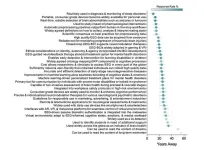(Press-News.org) Highlights:
Flu vaccine efficacy varies year to year.
A universal flu vaccine would protect people against all influenza strains that infect humans and last more than a season.
A new vaccine candidate incorporates proteins from 8 strains of influenza.
Recent tests of the candidate show efficacy in animal models, and the researchers hope to move to clinical trials soon.
Washington, D.C.—Annual flu vaccines protect against severe infection, but they vary in efficacy and may not match the most virulent strains of the season. The reality of a universal flu vaccine, which would protect people from all strains, and ideally longer than a single season, remains elusive.
Findings published this week in the Journal of Virology suggest we’re getting closer. Researchers at Cleveland Clinic’s Lerner Research Institute have reported that their universal flu vaccine candidate, tested on animal models, elicited a strong immune response and provided protection against severe infection after viral exposure. The new work builds on previous, similarly promising preclinical studies on mice from the same group, led by Ted M. Ross, Ph.D., Director of Global Vaccine Development at Cleveland Clinic.
The researchers hope to launch human clinical trials within 1-3 years, said virologist Naoko Uno, Ph.D., who led the new study. “We want to make sure our vaccine can span multiple seasons, not just one, and protect against all the strains that affect humans,” she said.
Scientists have identified 4 types of influenza virus, but 2 of them—Influenza A and Influenza B—pose the greatest risks to humans. Seasonal flu vaccines include proteins from 3 or 4 circulating subtypes of those viruses, which include H1N1, H3N2 and IBV. But because the virus mutates so quickly, predicting which strains will pose the biggest risk, and thus choosing which ingredients to include, is a guessing game.
Researchers in Ross’ lab designed their new vaccine candidate using a methodology called COBRA, or Computationally Optimized Broadly Reactive Antigens. They began by downloading thousands of genetic sequences of pathogenic influenza strains, spanning multiple seasons, from an online database. Then they digitally analyzed those sequences to identify which amino acids—the building blocks of proteins—are conserved across viruses and seasons.
The researchers identified groups of proteins for different subtypes. To develop a wider-reaching vaccine, Uno said, the group identified 8 proteins from those previous studies associated with a sustained immune response. “We’ve been able to whittle down this list, to say these are the best at spanning multiple seasons and eliciting a broadly reactive antibody response,” she said. “It’s like creating a greatest hits album. We want to put only the best ones back in the vaccine.”
Those greatest hits included proteins from H1 and H3 types of influenza viruses, Uno said, but they also included proteins from H2, H5 and H7 viruses, which are strains against which most people don’t have antibodies. Some of these have pandemic potential, Uno said. Past outbreaks of bird flu, or H5N1, have led to a high rate of human mortality, and in March 2024 the virus was found in dairy cattle in Texas. Since then, 4 people who work with cattle have been diagnosed. In addition, it has spread to dozens of herds in multiple states, and in other species including sea lions, birds, cats and alpacas.
“We’ve shown that our H5 vaccine does cover many different clades,” Uno said.
For the new work, the Cleveland Clinic researchers administered the vaccine candidate intranasally. Blood tests showed that 4 weeks later the animals had developed antibodies against the virus, and when the animals were exposed to the pathogen they were protected against developing infection.
Ross currently leads his group’s efforts to advance testing of the candidate in the U.S., and Uno is collaborating with researchers in India and the European Union on an international effort.
Uno noted that the COBRA methodology isn’t limited to finding and assembling recombinant proteins for the flu. It might be used to analyze mRNA or other biomolecules, she said, or explored for developing vaccines to viral diseases like dengue. “This can be used in a lot of viruses,” she said.
###
The American Society for Microbiology is one of the largest professional societies dedicated to the life sciences and is composed of over 32,000 scientists and health practitioners. ASM's mission is to promote and advance the microbial sciences.
ASM advances the microbial sciences through conferences, publications, certifications, educational opportunities and advocacy efforts. It enhances laboratory capacity around the globe through training and resources. It provides a network for scientists in academia, industry and clinical settings. Additionally, ASM promotes a deeper understanding of the microbial sciences to diverse audiences.
END
Universal flu vaccine candidate protects against infection in mice
2024-08-22
ELSE PRESS RELEASES FROM THIS DATE:
$20M community-driven research funding aims to reduce inequities, improve health outcomes
2024-08-22
DALLAS, August 22, 2024 — A new $20 million research initiative will engage the people most impacted by health disparities in developing solutions that may help improve their overall health and well-being. The American Heart Association, celebrating 100 years of lifesaving service as the world’s leading nonprofit organization focused on heart and brain health for all, and the Robert Wood Johnson Foundation (RWJF), a leading national philanthropy dedicated to taking bold leaps to transform health, are ...
Novel redox-active metal-organic framework as an anode material for Li batteries operating in freezing conditions
2024-08-22
The Korea Institute of Energy Research (KIER) has developed a redox-active metal-organic hybrid electrode material (SKIER-5) for Li batteries that remains stable in cold conditions as low as minus 20 degrees Celsius. By addressing the limitations of graphite as an anode material of conventional Li batteries under freezing conditions, SKIER-5 has the potential to be a superior alternative. This novel material can be used in Li batteries for a variety of applications, including electric vehicles, drones, and ultra-small electronic devices, even in low temperatures.
Currently, ...
Mental health and chronic diabetes complications strongly linked both ways, study finds
2024-08-22
Heart attack, stroke, nerve damage.
These are just some of the complications for which millions of Americans with diabetes are at greater risk.
When a person has any of these chronic diabetes complications, they are more likely to have a mental health disorder, and vice versa, according to a University of Michigan-led study.
That is, the relationship goes both ways: having a mental health condition also increases the risk of developing chronic complications of diabetes.
“We wanted to see if chronic diabetes complications ...
Endoscopic treatment approaches for inflammatory bowel diseases: old friends and new weapons
2024-08-22
Inflammatory bowel diseases (IBD), comprising Crohn’s disease (CD) and ulcerative colitis (UC), are chronic inflammatory conditions affecting the gastrointestinal tract. These diseases can lead to various complications, including strictures, fistulas, and abscesses, significantly impacting patients' quality of life. Endoscopy plays a crucial role in diagnosing IBD, assessing disease activity, and monitoring treatment response. In recent years, advances in operative endoscopy have introduced ...
Bed-sharing has no impact on children’s psychological development
2024-08-22
Parental bed-sharing is unlikely to impact children’s psychological development, new research has found.
The study from the University of Essex looked at nearly 17,000 British babies and tracked them for 11 years – finding kids who shared beds were happy and healthy.
Dr Ayten Bilgin, from the Department of Psychology, found no association between bed-sharing at 9 months and childhood emotional or behavioural problems.
The practice is mired in controversy as some experts previously thought it negatively affected children’s development.
However, others say it helps both parents and children as they are nearby for feeding and if they wake in the night.
Dr Bilgin, said: ...
Self-improving AI method increases 3D-printing efficiency
2024-08-22
PULLMAN, Wash. – An artificial intelligence algorithm can allow researchers to more efficiently use 3D printing to manufacture intricate structures.
The Washington State University study, published in the journal Advanced Materials Technologies, could allow for more seamless use of 3D printing for complex designs in everything from artificial organs to flexible electronics and wearable biosensors. As part of the study, the algorithm learned to identify, and then print, the best versions of kidney and prostate organ models, printing out 60 continually improving versions.
“You can optimize the results, saving time, cost and labor,” said Kaiyan Qiu, co-corresponding ...
Fighting coastal erosion with electricity
2024-08-22
New research from Northwestern University has systematically proven that a mild zap of electricity can strengthen a marine coastline for generations — greatly reducing the threat of erosion in the face of climate change and rising sea levels.
In the new study, researchers took inspiration from clams, mussels and other shell-dwelling sea life, which use dissolved minerals in seawater to build their shells.
Similarly, the researchers leveraged the same naturally occurring, dissolved minerals to form a natural cement between sea-soaked grains of sand. But, instead of using metabolic energy like mollusks ...
Detective algorithm predicts best drugs for genetic disorders and cancer
2024-08-22
A computational model built by researchers at the Institute of Research in Biomedicine (IRB Barcelona) and the Centre for Genomic Regulation (CRG) can predict which drugs will be most effective in treating diseases caused by mutations that can bring protein synthesis to a halt, resulting in unfinished proteins.
The findings, published today in Nature Genetics, mark an important step in helping personalise treatment by matching patients with specific mutations with the most promising drug candidate. The predictive model, a publicly ...
For first time, DNA tech offers both data storage and computing functions
2024-08-22
Researchers from North Carolina State University and Johns Hopkins University have demonstrated a technology capable of a suite of data storage and computing functions – repeatedly storing, retrieving, computing, erasing or rewriting data – that uses DNA rather than conventional electronics. Previous DNA data storage and computing technologies could complete some but not all of these tasks.
“In conventional computing technologies, we take for granted that the ways data are stored and the way data are processed are compatible with each other,” ...
Will EEG be able to read your dreams? The future of the brain activity measure as it marks 100 years
2024-08-22
One hundred years after the human brain’s electrical activity was first recorded, experts are celebrating the legacy of its discovery and sharing their predictions and priorities for its future.
Since the first recording in July 1924, human electroencephalography (EEG) has been integral to our understanding of brain function and dysfunction: most significantly in the clinical diagnosis of epilepsy, where the analysis of the EEG signal meant that a condition previously seen as a personality disorder was quickly redefined as a disorder of brain activity.
Now, a century on, more than 500 experts from around the globe, ...





